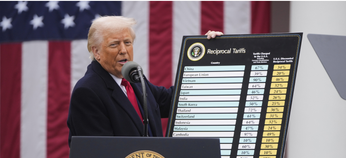
Russia’s surging budget revenues
Hello! Welcome to your weekly guide to the Russian economy — written by Alexander Kolyandr and Alexandra Prokopenko and brought to you by The Bell. This week our top story is a surge in tax revenues for the state. We also look at new sanctions on Russian metals.
Bumper budget income gives Moscow breathing room
Russian budget revenues were up by more than 50% in the first quarter of this year compared to 2023. In March, the state budget even recorded an overall surplus of 867 billion rubles ($9.3 billion). The growth in income was not entirely down to high oil prices, with tax income unrelated to natural resources also playing a role. So does that mean Russia’s treasury is now awash with cash, and can it better meet the record surge in spending?
Why are revenues increasing?
Both of the main components of Russia’s budget — energy and non-energy revenues — are up impressively so far this year. Oil and gas revenues in the first quarter were 79% higher than the same period last year at 2.9 trillion rubles ($32 billion). Non-oil and gas revenues came in at 3.3 trillion rubles ($35 billion), up 24%. The total budget deficit for the three-month period was 607 billion rubles ($6.5 billion), equivalent to 0.3% of Russia’s GDP. That is comfortably within the government’s plans for 2024, which envisages an overall budget deficit of 0.9% of GDP.
The increase in oil and gas revenues is linked to three main factors:
- High oil prices. Since January, benchmark Brent crude oil has traded above $80 per barrel, with the price clearing $90 in April. The United States is replenishing its reserves, boosting demand at the same time OPEC+ production cuts limit supply. The conflict in the Middle East as well as the spate of Houthi attacks on ships in the Red Sea are also pushing up prices.
- New tax calculations. Russia’s oil taxes no longer depend on export volumes, which allows the government to rake in higher revenues even as it abides by OPEC+ agreements. Back in 2023, the finance ministry changed the way it calculates the Mineral Extraction Tax (MET), the main resource tax. It is now based on the higher of i) Brent prices minus a set discount ($20 a barrel since Jan 1), or ii) the price of Urals at Russian ports plus the shipping tariff to Europe. The shipping tariff is currently set at $2 a barrel, but there are plans to introduce a specialized calculation for this. In simple terms, the ministry does not care how much oil is actually being exported since the tax is now levied “at the well.” Last year the formula was different, hence the bumper growth in revenues this time aroundd. Russia's energy revenues were also hit hard at the start of 2023 in the first months of the West’s oil price cap.
- Windfall taxes. Oil companies paid more in quarterly additional income tax and one-off MET payments increased to compensate the government for unsuccessful subsidies paid out to oil companies. Those payments were valued at 190 billion rubles ($2 billion).
The finance ministry anticipates that higher oil and gas revenues will continue. “Exporters have established supply chains,” Finance Minister Anton Siluanov said recently, downplaying the impact of the oil price cap and other Western sanctions. Even if one-off factors and favorable year-on-year comparisons will be less of a factor in future quarters, the new tax formula, combined with high oil prices, means the ministry can easily reach its revenue targets.
The increase in non-energy revenues is being driven by Russia’s overall economic growth. Higher domestic demand and more spending has resulted in more income for the state — primarily through sales (VAT) and turnover taxes. Even amid high inflation, people are earning more and spending more, Raiffaisen Bank analysts say.
The Russian economy accelerated last year on the back of increased budget spending and import substitution, or higher demand for the kinds of intermediate goods and services needed to replace foreign components. In the first quarter of this year there was no sign of a slowdown, despite interest rates of 16%. Russia’s GDP was up 4.6% in January and 7.7% in February (when the extra day on Feb. 29 provided an additional boost).
What’s next?
Key business sentiment indicators, such as the central bank’s business climate indicator and optimism in industry, are running high. The manufacturing purchasers’ managers index (PMI), a key reading of business confidence, has reached its highest level in almost 18 years. Even though businesses have a positive view of their future, they lack the capacity to increase supply and keep pace with demand. There is little free manpower in the economy and as a result, salaries will continue to rise, outpacing labor productivity (which is also inhibited by tech sanctions). These dynamics underpin the growth in domestic demand as well as non-oil and gas budget revenues in nominal terms, but also lead to an acceleration in inflation.
The International Monetary Fund (IMF) has raised its forecast for Russia’s economic growth to 3.2% in 2024 — ahead of predictions from Russia’s own economy ministry (2.3%) and the central bank (1-2%). Those forecasts are also set to be revised higher at the next review. The IMF said it sees the Russian economy staying overheated, rather than slowing down.
Domestic demand will be further supported in the second quarter of the year by government spending. According to the consolidated budget schedule, by mid-April, the ministry had allocated 11.7 trillion rubles out of a planned 37.3 trillion — a slower rate of spending than in 2023 when the government front-loaded some large expenditures.
The finance ministry has anticipated additional spending, beyond that already approved, of 1 trillion rubles ($10.7 billion) a year to include funding for Putin’s election promises. For the moment, the plan is to pay for them through spending cuts in other areas as well as higher taxes. Siluanov has dodged questions about exactly how. IStories has reported on potential plans to increase the maximum rate of personal income tax from 15% to 20% and raise corporate tax rates to 25%. The latter could generate up to 2 trillion rubles ($21.4 billion) a year. The final parameters will be agreed when the newly-formed government is unveiled (which will probably be by May 20).
The finance ministry is aiming for a budget deficit of 1.4-1.5 trillion rubles ($15-16 billion) for 2024, which would meet the official plans for a shortfall of 0.9% of GDP. At the moment, that looks achievable. The budget is being supported by a widening current account surplus — up 43% year-on-year to $22 billion in the first quarter. Russia’s imports and exports both decreased, but the former fell more sharply (a 10% drop in imports compared to 5% for exports), even when adjusted for difficulties in calculation (you can read more about this here). The increased current account balance was also linked to shallower deficits in the primary and secondary accounts as dividends payable to non-residents decreased and there was a fall in the value of personal transfers abroad.
Moscow has earmarked using cash from the National Wealth Fund (NWF) alongside bond placements (4.1 trillion rubles is planned to be raised in debt in 2024) to cover this year’s annual deficit. With interest rates of 16%, taking on more debt is clearly an expensive endeavor. Papers with floating interest rates represent 50% of Russian government borrowing and changes in the central bank’s key rate increase the risk to the budget. In 2019, servicing the national debt took up 3.6% of budget spending. In 2024 that will almost have doubled to 6.5%. Siluanov said it could reach 9.7% in 2026.
The finance ministry has also restated its commitment to the current formulation of the budget rule — which governs the relationship between oil prices, FX purchases and contributions or drawdowns from the NWF. Siluanov has pledged to deliver a balanced budget in 2025.
Why the world should care
Russia’s government finances look to be in a comfortable position. If the current dynamics continue, then the finance ministry will be able to fund its planned spending and stay within its target deficit parameters.
The big external risk is a possible tightening of oil sanctions, which could lead to a fall in export revenues. For now there seems little likelihood of this. But for Russia’s economy, an excess of money could be an even greater problem than a shortfall. As budget revenues rise, there will be an irresistible urge to spend more. One key unknown in the government’s spending plans is the situation at the front and Moscow’s future military plans, which could require higher outlays.
Where will sanctions on Russian metals lead?
Since April 13, the USA and Britain have imposed bans on the import of Russian aluminum, copper and nickel. The direct ban on purchases has little impact on supply in the UK or the US, since neither country buys significant quantities from Russia. Instead the aim is to effectively close-off Russia’s access to two of the world’s leading trading platforms — the London Metal Exchange (LME) and the Chicago Mercantile Exchange (CME).
Neither exchange is permitted to trade contracts for Russian metals or store products in their warehouses if they were certified after April 13. The sanctions do not affect metals produced before this date, nor can they target bilateral transactions or deals reached outside those two exchanges.
So far, the Russian metals industry has responded calmly. At this stage, sanctions strengthen their hand in their other dealmaking. After the restrictions landed, metal prices immediately shot up. On April 15, the price of nickel and copper went up 1.5%. Aluminum rose 9.4%, an intraday rise last seen in 1987.
Russian metals have long been a huge part of LME’s warehouse. Russian aluminum at one point accounted for 90% of its stock, with buyers already reluctant to get involved for fear of sanctions. Traders may also have thought it was priced at a discount amid the sanctions uncertainty. Now that regulators have set out their positions and ruled accordingly, making the situation clearer, that discount could evaporate.
Why the world should care
Higher metals prices, and the windfall earnings they are bringing for Russian firms, are unlikely to last long. Russia has already reduced its sales on global exchanges, so the rise in spot prices does not accurately reflect the real relationship between supply and demand for Russian products. Russia will continue trying to sell metals to China, Turkey and the Gulf states. Much will depend on China's economic performance, particularly its troubled construction sector. The industry has stagnated lately, suggesting there is unlikely to be higher demand for Russian metals.
Figures of the week
- Weekly inflation slowed from 0.16% to 0.12% between April 9-15, according to the economy ministry. At the same time, annual inflation accelerated from 7.79% to 7.83%. Food prices were up 0.1% in the week. Prices for gasoline and diesel fuel continued to rise (up 0.3% and 0.2% respectively) and tickets for domestic flights increased the most in the basket, up 3.92%.
- The central bank’s monthly survey of economists showed expectations for the key rate have risen, with participants seeing the rate averaging 14.9% this year, compared with 14.4% in the March survey. They also predicted higher GDP growth at 2.1%, compared with 1.8%. Forecasts for Russia’s long-term growth potential stood unchanged at 1.5%. Inflation expectations are also unchanged at 5.2% for 2024, before they see it moving closer to the official 4% target in 2025.
- The public’s inflation expectations continued to fall in April. They now stand at 11% for the coming year, down 0.5 percentage points from March. Observed inflation — or how fast people think prices are changing — also fell 0.4 percentage points to 14.4%.
- The raft of Chinese banks that have practically ceased accepting payments in yuan from Russia continues to grow. It now includes China’s largest bank, ICBC, as well as China CITIC Bank, Industrial Bank and Bank of Taizhou. The situation with payments from Russia to China deteriorated sharply in late March when about 80% of attempted payments were rejected. The Bank of China also introduced restrictions, but it handles only a small share of transactions from Russia.
- Russia’s Federal Anti-Monopoly Service banned shops from raising egg prices ahead of Orthodox Easter. At the end of last year, egg prices were a hot topic, with 10 eggs selling for 190-200 rubles ($2-$2.10) in several regions. In 2023, prices shot up 59%, making them one of the most expensive food products in the consumer basket, according to Rosstat data.
Further reading
The Five Futures of Russia And How America Can Prepare for Whatever Comes Next
The Talks That Could Have Ended the War in Ukraine
Personnel Stagnation to Splinter Putin Elite With Battle of Lost Generations



PAID SUBSCRIPTION LAUNCH
From May 1, 2025, The Bell in English will no longer be free
From May 1, 2025, all The Bell’s newsletters and online content will be behind a paywall. We have taken this decision so that The Bell can remain financially independent, and maintain our high standards of journalism and economic expertise






